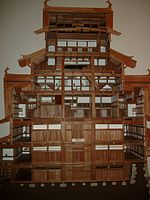Nakazonae



Nakazonae (中備・中具) is a Japanese classification of several intercolumnar struts of different origin installed in the intervals between bracket complexes (斗拱tokyō) at wooden architectures in East Asia.[1]
In origin they were necessary to help support the roof; however, at the end of the 10th century the invention of the hidden roof[note 1] made them superfluous.[2] They remained in use, albeit in a purely decorative role, and are typical of the Wayō style. The Zenshūyō style used by Zen temples has instead bracket complexes even between posts.
Shuzhu or Kentozuka
[edit]The simplest of these struts are the kentozuka (間斗束, lit. interval block strut, see photo above) composed of a short post and a bearing block.[3]
Minozuka
[edit]Similar to the kentozuka is the fan-shaped strut called minozuka (蓑束, lit. straw raincoat strut) (see gallery), which can have decorations on the two sides called 笈形 (oigata) or a collar-like decoration between post and bearing block. The name comes from its shape, similar to that of a traditional straw raincoat called mino.[4]
Hana-hijiki
[edit]A variant of the hijiki (肘木) or timu (替木) is the hana-hijiki (花肘木), composed by either one or two horizontal series bearing blocks standing over an elaborately carved floral pattern.[1]
Renzigong or Warizuka
[edit]The 人-shaped dougong (Chinese: 人字栱) warizuka (割束) strut consists of a wooden inverted V topped by a bearing block.[3]
Kaerumata or Tuofeng
[edit]The kaerumata (蛙股・蟇股, lit. frog legs) or tuofeng (駝峰) was named after its shape, resembling a frog's splayed legs.[1]
Its origins are not known with certainty, but it may be an evolution of the warizuka.[1] Invented during the 12th century, it became gradually more and more elaborate, to the point where in the Edo period the strut itself would be hidden behind the decorations.[1]
Two basic types exist. In the case of the sukashi-kaerumata (透蟇股), the space above and between the frog legs is either empty or carved. In the case of the ita-kaerumata (板蟇股), the space between the legs has completely disappeared, leaving behind a solid board with an external frog-leg profile.[5]
Types of nakazonae
[edit]-
Warizuka (sides) and tokyō (center) (Hōryū-ji)
-
Sukashi-kaerumata (Kitano Tenman-gū)
-
Hana-hijiki, center, between two tokyō (Hōryū-ji, Nandaimon)
Notes
[edit]References
[edit]- ^ a b c d e Nishi, Kazuo; Hozumi, Kazuo (1996) [1983]. What is Japanese architecture? (illustrated ed.). Kodansha International. pp. 39–40. ISBN 4-7700-1992-0.
- ^ Parent, Mary Neighbour. "Nakazonae". Japanese Architecture and Art Net Users System. Retrieved April 28, 2011.
- ^ a b Parent, Mary Neighbour. "Kentozuka". Japanese Architecture and Art Net Users System. Retrieved April 19, 2011.
- ^ Parent, Mary Neighbour. "Minozuka". Japanese Architecture and Art Net Users System. Retrieved April 28, 2011.
- ^ Parent, Mary Neighbour. "Kaerumata". Japanese Architecture and Art Net Users System. Retrieved April 19, 2011.






